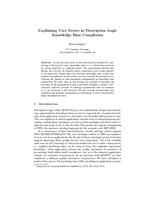LATPub379: Unterschied zwischen den Versionen
Aus International Center for Computational Logic
Marcel Lippmann (Diskussion | Beiträge) KKeine Bearbeitungszusammenfassung |
Marcel Lippmann (Diskussion | Beiträge) KKeine Bearbeitungszusammenfassung |
||
| (2 dazwischenliegende Versionen desselben Benutzers werden nicht angezeigt) | |||
| Zeile 9: | Zeile 9: | ||
|Year=2008 | |Year=2008 | ||
|Month= | |Month= | ||
|Booktitle=Informal Proceedings of the 2008 International Workshop on Complexity, Expressibility, and Decidability in Automated Reasoning ( | |Booktitle=Informal Proceedings of the 2008 International Workshop on Complexity, Expressibility, and Decidability in Automated Reasoning (CEDAR'08) | ||
|Editor= | |Editor= | ||
|Note= | |Note= | ||
| Zeile 20: | Zeile 20: | ||
}} | }} | ||
{{Publikation Details | {{Publikation Details | ||
|Abstract= | |Abstract=In our previous work we have developed a method for completing a Description Logic knowledge base w.r.t. a fixed interpretation by asking questions to a domain expert. Our experiments showed that during this process the domain expert sometimes gives wrong answers to the questions, which cause the resultant knowledge base to have unwanted consequences. In the present work we consider the problem of explaining the reasons of such unwanted consequences in knowledge base completion. We show that in this setting the problem of deciding the existence of an explanation within a specified cardinality bound is NP-complete, and the problem of counting explanations that are minimal w.r.t. set inclusion is #P-complete. We also provide an algorithm that computes one minimal explanation by performing at most polynomially many subsumption tests. | ||
In our previous work we have developed a method for | |||
completing a Description Logic knowledge base w.r.t. a fixed interpretation | |||
by asking questions to a domain expert. | |||
Our experiments showed that during this process the domain expert sometimes | |||
gives wrong answers to the questions, which cause the resultant knowledge base | |||
to have unwanted consequences. In the present work we consider the problem of | |||
explaining the reasons of such unwanted consequences in knowledge base | |||
completion. We show that in this setting the problem of deciding the existence | |||
of an explanation | |||
within a specified cardinality bound is NP-complete, and the problem of | |||
counting explanations that are minimal w.r.t. set inclusion is #P-complete. | |||
We also provide an algorithm that computes one minimal explanation by | |||
performing at most polynomially many subsumption tests. | |||
|ISBN= | |ISBN= | ||
|ISSN= | |ISSN= | ||
| Zeile 49: | Zeile 35: | ||
year = {2008}, | year = {2008}, | ||
} | } | ||
}} | }} | ||
Aktuelle Version vom 25. März 2015, 16:34 Uhr
Explaining User Errors in Description Logic Knowledge Base Completion
Barış SertkayaBarış Sertkaya
Barış Sertkaya
Explaining User Errors in Description Logic Knowledge Base Completion
Informal Proceedings of the 2008 International Workshop on Complexity, Expressibility, and Decidability in Automated Reasoning (CEDAR'08), 2008
Explaining User Errors in Description Logic Knowledge Base Completion
Informal Proceedings of the 2008 International Workshop on Complexity, Expressibility, and Decidability in Automated Reasoning (CEDAR'08), 2008
- KurzfassungAbstract
In our previous work we have developed a method for completing a Description Logic knowledge base w.r.t. a fixed interpretation by asking questions to a domain expert. Our experiments showed that during this process the domain expert sometimes gives wrong answers to the questions, which cause the resultant knowledge base to have unwanted consequences. In the present work we consider the problem of explaining the reasons of such unwanted consequences in knowledge base completion. We show that in this setting the problem of deciding the existence of an explanation within a specified cardinality bound is NP-complete, and the problem of counting explanations that are minimal w.r.t. set inclusion is #P-complete. We also provide an algorithm that computes one minimal explanation by performing at most polynomially many subsumption tests. - Forschungsgruppe:Research Group: AutomatentheorieAutomata Theory
@inproceedings{ Sert08b,
author = {Bar\i{}\c{s} {Sertkaya}},
booktitle = {Informal Proceedings of the 2008 International Workshop on Complexity, Expressibility, and Decidability in Automated Reasoning ({CEDAR'08})},
title = {Explaining User Errors in Description Logic Knowledge Base Completion},
year = {2008},
}
